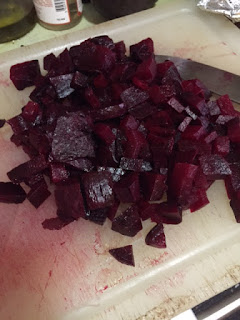Perhaps there are some of you wondering: how do I use the leftovers in a healthy, non fattening way? Well.... Annalena is sorry to be the one carrying the news: if your mashed potatoes were made with butter and cream (as hers were), they cannot be made healthy and non fattening. Indeed, it amazes Annalena sometimes, how people try to figure out how to make a high calorie ingredient a low calorie one: it is not a matter of watering the vanilla (you remember the Mary Tyler Moore episode, don't you?). So eliminate the guilt, own the situation, and either deal with the not so healthy leftovers, or share them (that is what Annalena is doing with her desserts), or... balance them with something less than obnoxious nutritionally.
Annalena read this recipe, in a column about a restaurant where they try to reuse everything: this extends to taking eggshells, and using them as molds for custards, making carrot top green sauce, etc. This soup was one that was based on - she kids you not - the juice from a jar of sauerkraut.
Now, this did not seem strange at all to Annalena, as she saves her pickle juice for making rye bread (and it's GOOD ragazzi). She and her gal pal Sue also use their potato water to bake bread (you will get higher loaves). So repurposing is good. And the soup recipe had a lot of things in it that are good for you, filling, and not so costly. So, ragazzi, let's try to make this. Put a bowl of it next to your loaded turkey sandwich (or your shepherd's pie), and you may not be tempted to eat a second portion of either.
We begin with beets: a pound and a half of them. This is the time to use the beets that are as big as your head. (Annalena recalls a story where her beloved trainer Emily ordered 3 pounds of beets on line and got one, large beet). Annalena's were not that large, but two were more than sufficient. You put these in a non reactive pot, 1/3 covered with water, and seal this with foil. Then bake it at 375 for "as long as it takes." The bigger the beet, the longer. It took 75 minutes for Annalena to get hers to the point where a knife pierced the beet to the center, easily. These will be hot: VERY hot. Leave them alone, and then let them cool:
You can see the size of Annalena's beets, next to an avocado. If you wait until they are cool, and run them under cold water, they will peel, easily. You don't want the stems of the beets, so get rid of them and cube the critters: Next, you will want some red cabbage sauerkraut. Look for it. It's available. And it is becoming more common. This is the type Annalena uses: You want a cup and a half of that, or all of it, if you see fit. There will be some juice left over. Save it for now.
Finally, you will want savoy cabbage. You can use a regular cabbage, but savoy is better, and it is sweeter. Here's a savoy:
And you'll want to thinly slice about a half pound of that. If you start with the outside leaves, which you can do, you will use a lot more than you think:
Now, dice up a big fennel bulb, and a large yellow onion (although given the theme of this soup , you could use red too):
Finally, slice 9 garlic cloves.
Let's go through those ingredients: beets, cabbage, sauerkraut, fennel, onion, garlic. Not an expensive one in the bunch, and certainly we're getting our share of fiber.
We start by adding the onion and fennel to a pot containing a film of olive oil, and cooking to translucence:
Now, you add the garlic, the cabbage, the beets. Remember Annalena told you to keep the sauerkraut juice? Measure it. You are going to want a cup and a half, and if you don't have it, (Annalena didn't), well, go drain some pickles. In a pinch, you can make vinegar water by adding a quarter cup of vinegar to a cup of regular water, but you SHOULD have some pickles in your house. First, put a half cup of the sauerkraut water into the pot, and then add enough water to cover the vegetables. Bring this to a simmer, and add the rest of your pickle juice/sauerkraut juice/vinegar water, and let the stuff cook, for about fifteen minutes:
Taste it. You want a distinctly sour, tangy taste. You also want a strong salt element. Adjust as need be, with vinegar (cider vinegar is best here, not red wine vinegar), and then, serve it forth:
To Annalena, this soup cries out for rye or pumpernickel bread, preferably with good butter. Be generous with the bread, stingy with the butter. Or, if you have boiled potatoes lying around, dice them up and add them to the soup and make it a meal. It's vegan, it's sort of biodynamic, and it's GOOD. Not so many calories, eh? A way to clean out that pumpkin pie.
Enjoy ragazzi. We want our plumbing clean before the Christmas cookie orgies begin






































